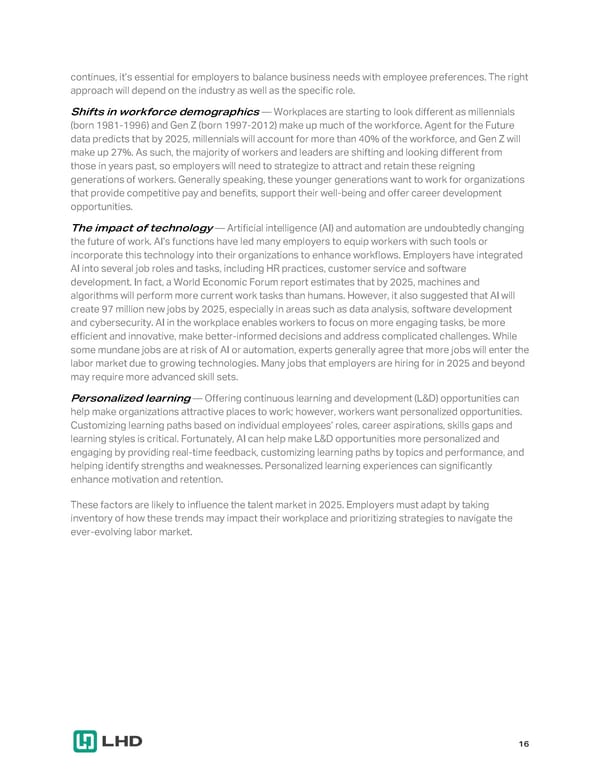continues, it’s essential for employers to balance business needs with employee preferences. The right approach will depend on the industry as well as the specific role. Shifts in workforce demographics — Workplaces are starting to look different as millennials (born 1981-1996) and Gen Z (born 1997-2012) make up much of the workforce. Agent for the Future data predicts that by 2025, millennials will account for more than 40% of the workforce, and Gen Z will make up 27%. As such, the majority of workers and leaders are shifting and looking different from those in years past, so employers will need to strategize to attract and retain these reigning generations of workers. Generally speaking, these younger generations want to work for organizations that provide competitive pay and benefits, support their well-being and offer career development opportunities. The impact of technology — Artificial intelligence (AI) and automation are undoubtedly changing the future of work. AI’s functions have led many employers to equip workers with such tools or incorporate this technology into their organizations to enhance workflows. Employers have integrated AI into several job roles and tasks, including HR practices, customer service and software development. In fact, a World Economic Forum report estimates that by 2025, machines and algorithms will perform more current work tasks than humans. However, it also suggested that AI will create 97 million new jobs by 2025, especially in areas such as data analysis, software development and cybersecurity. AI in the workplace enables workers to focus on more engaging tasks, be more efficient and innovative, make better-informed decisions and address complicated challenges. While some mundane jobs are at risk of AI or automation, experts generally agree that more jobs will enter the labor market due to growing technologies. Many jobs that employers are hiring for in 2025 and beyond may require more advanced skill sets. Personalized learning — Offering continuous learning and development (L&D) opportunities can help make organizations attractive places to work; however, workers want personalized opportunities. Customizing learning paths based on individual employees’ roles, career aspirations, skills gaps and learning styles is critical. Fortunately, AI can help make L&D opportunities more personalized and engaging by providing real-time feedback, customizing learning paths by topics and performance, and helping identify strengths and weaknesses. Personalized learning experiences can significantly enhance motivation and retention. These factors are likely to influence the talent market in 2025. Employers must adapt by taking inventory of how these trends may impact their workplace and prioritizing strategies to navigate the ever-evolving labor market. 16
 2025 Employee Benefits Market Outlook Page 15 Page 17
2025 Employee Benefits Market Outlook Page 15 Page 17